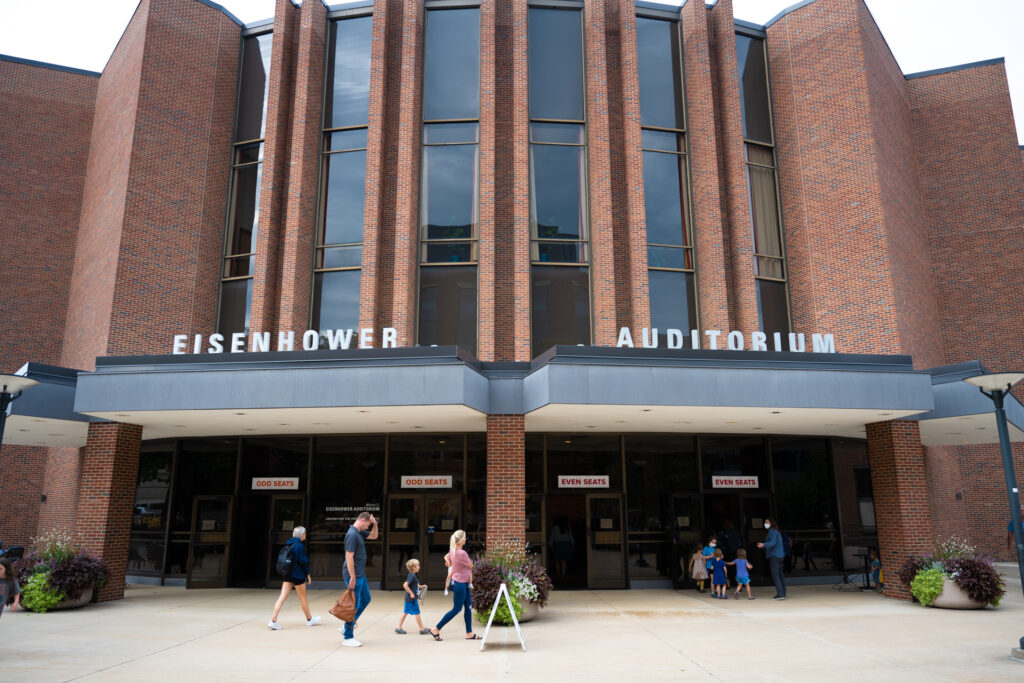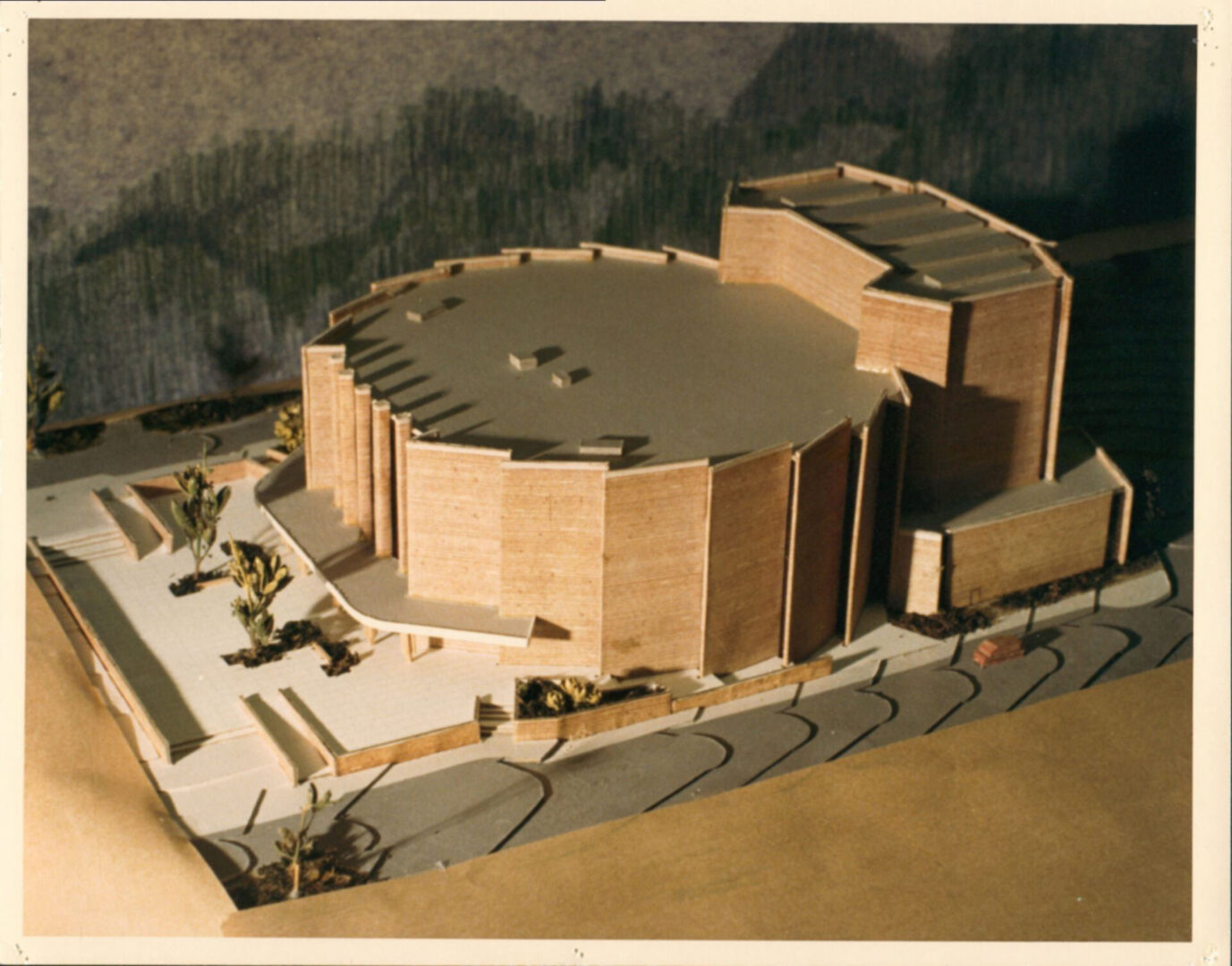In the fifty years since its dedication, Eisenhower Auditorium has hosted a who’s who of notable twentieth- and twenty-first-century music, theatre, and dance, and all manner of performance artists from around the world and the University Park campus.
Conceptualized as home base for the Penn State Artists Series of professional staged programs, the auditorium’s acoustic-friendly layout and ample seating have made it a popular rental venue for a variety of university clubs, community organizations, and touring performers for decades. Since its opening in May 1974, the venue has been designated a professional artist’s stage, a classroom, a religious worship hall, a volunteer’s destination, a graduation ceremony rite of passage, and a cultural and community connector.
The Center for the Performing Arts at Penn State has its roots in the Artists Series, which began in 1957 under the leadership of Albert Christ-Janer, first director of Penn State’s School of the Arts. Starting that year, Nina Brown guided the Artists Series through a couple of iterations and for almost three decades. In the early years, most presentations were in Schwab Auditorium, and events that required more seats took place in the Recreation Building (Rec Hall). However, both spaces lacked the acoustics and seating desired for artistic performances.
“Schwab Auditorium had a shallow stage and no real backstage to present theatre,” Brown said. “We often presented multiple performances to accommodate the demand for tickets. Rec Hall had uncomfortable seating—folding chairs on the floor with bleacher seating on the sides. … The stage was very noisy for ballet and any kind of dance.”
University Auditorium (today’s Eisenhower Auditorium) met that need. The new auditorium had the space and equipment to present a greater variety of events and seating for about 2,500—almost three times as many patrons as could be accommodated at Schwab.
Eisenhower Auditorium was built by the General State Authority of the Commonwealth at a cost of almost $6 million. The new building helped to lend an “arts district” feel on campus, with its proximity to the schools of music, theatre, and visual arts, as well as the then-new Palmer Museum of Art.
“The completion of this outstanding complex affords Penn State the unique opportunity to undertake fresh approaches to promoting student, alumni, and public interest in and understanding of a broad spectrum of the arts,” stated a 1974 pamphlet on The Arts at Penn State.
The final event of the 1973-74 Artist Series, a three-night concert featuring the Pittsburgh Symphony Orchestra and the Penn State University Choirs, christened the new auditorium in May 1974. Each night’s event—May 8, 9, and 10, 1974—sold out, and the opening-night audience called the artists back for three encores with a standing ovation. It was the height of sophistication, featuring internationally renowned musicians in rural central Pennsylvania.
“Tuxedos and chiffon. Conversation concerning a Paris opera house. And in the background the Pittsburgh Symphony Orchestra tuning up for its performance,” wrote Daily Collegian staff writer Sheila McCauley.
Penn State President John W. Oswald opened the venue by thanking Walter H. Walters, dean of the College of Arts and Architecture. Then he introduced the orchestra with Ludwig van Beethoven’s words: “Music should strike fire in the heart of man.”
Each performance featured the Pittsburgh Symphony Orchestra conducted by William Steinberg and the University Choirs directed by Raymond Brown (husband of first Artists Series Director Nina Brown). Guest soloists soprano Phyllis Curtin, mezzo Betty Allen, tenor Seth McCoy, and bass Ara Berberian accompanied the ensembles. The program included Beethoven’s Ninth Symphony and Hector Berloiz’s overture to “Benvenuto Cellini.”
That July, the Pennsylvania Ballet presented two world premieres on the Eisenhower stage during the company’s first of many residencies. Beginning in fall 1974, most Artists Series events took place in the new auditorium, while chamber music concerts stayed in Schwab. The auditorium’s first season schedule included visits by Royal Shakespeare Company; Marcel Marceau; Martha Graham Dance Company; Bradford native and soprano Marilyn Horne; and a return of the Pittsburgh Symphony Orchestra.
The new space created opportunities for local organizations, and University Auditorium became the venue of choice for a host of college and community events, including the University Concert Committee’s rock shows, Greek Sing, and local performances of The Nutcracker. The College of Arts and Architecture hired a full-time staff, known as Auditorium Management, to handle administration and production in the new facility.

University Auditorium was renamed Eisenhower Auditorium in 1977, dedicated after Penn State’s eleventh president, Milton Stover Eisenhower, who served from 1950 to 1956. In 1985, Penn State merged the facilities and program management into one group, and the Center for the Performing Arts was born.
From its opening, Eisenhower Auditorium was an automatic destination for artists and students seeking a stage. Its physicality made it a no-brainer as a performance and presentation space as well as for special programs—such as a Pennsylvania governor’s debate or a ceramics convention.
Eventually, the midcentury-era sculptures and blank space paved the way for white walls open to student and community artists with diverse stories.
Most recently, the bold theatrical program by 600 Highwaymen, An Assembly: A Thousand Ways, held in nondescript spots throughout Eisenhower Auditorium, applied an unmoderated, patron-is-the-artist approach to group performance. And returning in the 2024-25 season will be a call for Penn State student artists to help make the walls of the building more vibrant. T&G
Heather Longley is a marketing communications associate at the Center for the Performing Arts.




